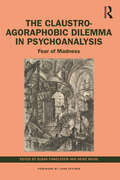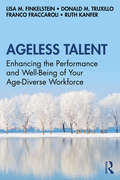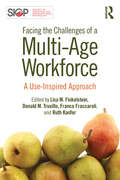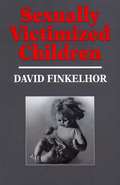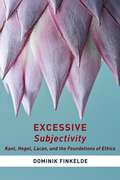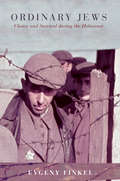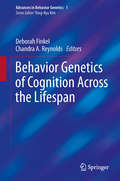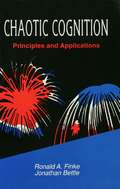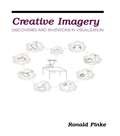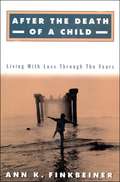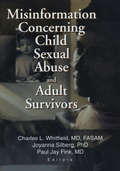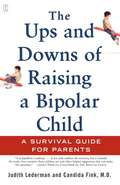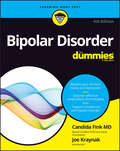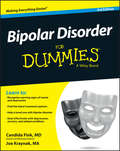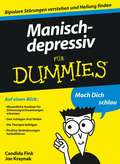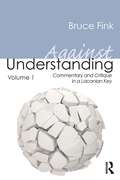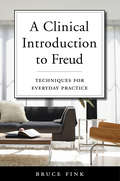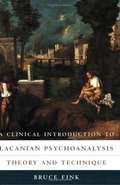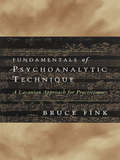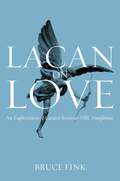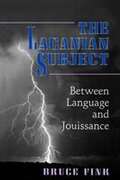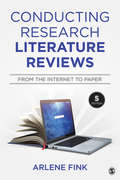- Table View
- List View
The Claustro-Agoraphobic Dilemma in Psychoanalysis: Fear of Madness
by Susan Finkelstein Heinz WeissThis collection addresses the theory of claustro-agoraphobic anxieties and schizoid phenomena. It provides psychoanalytic case studies of the transference and counter-transference dynamic inherent in these agonizing disorders. In The Claustro-Agoraphobic Dilemma in Psychoanalysis: Fear of Madness, Susan Finkelstein and Heinz Weiss gather both classic papers and new essays, presenting a timely assessment of claustro-agoraphobia as first developed by Henri Rey. This volume includes papers by Helene Deutsch, Bertram Lewin, Edoardo Weiss, Esther Bick, Donald Meltzer, Albert Mason, John Steiner, and Claudia Frank, as well as a chapter by Kristin White on working remotely with psychoanalytic patients during the Covid-19 pandemic. Applying a Freudian, Kleinian, and Bionian methodology, this collection argues for a long-term approach to psychoanalytic treatment in order to help claustro-agoraphobic patients work through the unconscious conflicts that interfere with their capacity to engage in a committed relationship. This book is essential reading for psychoanalysts in practice and training and will appeal to academics and historians interested in the universality of spiritual and mythic motifs.
Ageless Talent: Enhancing the Performance and Well-Being of Your Age-Diverse Workforce
by Lisa M. Finkelstein Donald M. Truxillo Franco Fraccaroli Ruth KanferAgeless Talent: Enhancing the Performance and Well-Being of Your Age-Diverse Workforce provides organizational leaders, managers, and supervisors with clear, evidence-based tactics by which to develop and manage an aging and age-diverse talent pool. This volume provides an easy-to-implement set of tools for addressing the difficult problems related to employee performance and well-being amid ongoing technological and social change. Ageless Talent introduces a straightforward framework (PIERA) that translates scientific advances into actionable steps and strategies. Using this framework, this book provides practical illustrations to help readers design their own small-scale interventions to achieve desirable goals under diverse organizational constraints. Furthermore, the book addresses modern management challenges arising across the globe, and offers suggestions for leaders interested in short-term and long-term change. These suggestions, grounded in time-tested and leading-edge research evidence, include specific step-by-step guidelines, customizable to different types of organizations and industries. With economic, cultural, technological, and demographic shifts making the changing nature of work a pressing concern for organizations around the globe, Ageless Talent is an essential text for practitioners – HR professionals, organizational leaders, and managers – as well as management education programs and professional training and leadership programs. It will also appeal to instructors and students in the field of industrial/organizational psychology.
Facing the Challenges of a Multi-Age Workforce: A Use-Inspired Approach (SIOP Organizational Frontiers Series)
by Lisa M. Finkelstein Franco Fraccaroli Donald M. Truxillo Ruth KanferFacing the Challenges of a Multi-Age Workforce examines the shifting economic, cultural, and technological trends in the modern workplace that are taking place as a result of the aging global workforce. Taking an international perspective, contributors address workforce aging issues around the world, allowing for productive cross-cultural comparisons. Chapters adopt a use-inspired approach, with contributors proposing solutions to real problems faced by organizations, including global teamwork, unemployed youth, job obsolescence and over-qualification, heavy emotional labor and physically demanding jobs, and cross-age perceptions and communication. Additional commentaries from sociologists, gerontologists, economists, and scholars of labor and government round out the volume and demonstrate the interdisciplinary nature of this important topic.
Sexually Victimized Children
by David FinkelhorBased on a large-scale survey and in light of demographic and cultural factors, the author examines why children are sexually victimized, the sources of trauma, differences between reported and unreported cases of assault, and possible increases in sexual victimization.
Excessive Subjectivity: Kant, Hegel, Lacan, and the Foundations of Ethics (Insurrections: Critical Studies in Religion, Politics, and Culture)
by Dominik FinkeldeHow are we to conceive of acts that suddenly expose the injustice of the prevailing order? These acts challenge long-standing hidden or silently tolerated injustices, but as they are unsupported by existing ethical rules they pose a drastic challenge to dominant norms. In Excessive Subjectivity, Dominik Finkelde rereads the tradition of German idealism and finds in it the potential for transformative acts that are capable of revolutionizing the social order.Finkelde's discussion of the meaning and structure of the ethical act meticulously engages thinkers typically treated as opposed—Kant, Hegel, and Lacan—to develop the concept of excessive subjectivity, which is characterized by nonconformist acts that reshape the contours of ethical life. For Kant, the subject is defined by the ethical acts she performs. Hegel interprets Kant's categorical imperative as the ability of an individual's conscience to exceed the existing state of affairs. Lacan emphasizes the transgressive force of unconscious desire on the ethical agent. Through these thinkers Finkelde develops a radical ethics for contemporary times. Integrating perspectives from both analytical and continental philosophy, Excessive Subjectivity is a distinctive contribution to our understanding of the ethical subject.
Ordinary Jews: Choice and Survival during the Holocaust
by Evgeny FinkelFocusing on the choices and actions of Jews during the Holocaust, Ordinary Jews examines the different patterns of behavior of civilians targeted by mass violence. Relying on rich archival material and hundreds of survivors' testimonies, Evgeny Finkel presents a new framework for understanding the survival strategies in which Jews engaged: cooperation and collaboration, coping and compliance, evasion, and resistance. Finkel compares Jews' behavior in three Jewish ghettos—Minsk, Kraków, and Białystok—and shows that Jews' responses to Nazi genocide varied based on their experiences with prewar policies that either promoted or discouraged their integration into non-Jewish society. Finkel demonstrates that while possible survival strategies were the same for everyone, individuals' choices varied across and within communities. In more cohesive and robust Jewish communities, coping—confronting the danger and trying to survive without leaving—was more organized and successful, while collaboration with the Nazis and attempts to escape the ghetto were minimal. In more heterogeneous Jewish communities, collaboration with the Nazis was more pervasive, while coping was disorganized. In localities with a history of peaceful interethnic relations, evasion was more widespread than in places where interethnic relations were hostile. State repression before WWII, to which local communities were subject, determined the viability of anti-Nazi Jewish resistance.Exploring the critical influences shaping the decisions made by Jews in Nazi-occupied eastern Europe, Ordinary Jews sheds new light on the dynamics of collective violence and genocide.
Behavior Genetics of Cognition Across the Lifespan (Advances in Behavior Genetics #1)
by Deborah Finkel Chandra A. ReynoldsAlong with psychopathology, cognition has been one of the primary phenotypic focal points of the field of behavior genetics since its inception. Francis Galton's 1874 examination of eminent families in Britain was among the earliest attempts to investigate whether cognitive achievements run in families. This volume presents current methodologies for understanding cognitive abilities that move beyond the outdated nature vs. nurture paradigm. Recent advances in both collection and statistical modeling of twin data, particularly longitudinal twin data, make this an especially advantageous moment to produce a work that presents a collection of the groundbreaking research on cognitive abilities across the lifespan. This volume presents an overview of the current state of quantitative and molecular genetic investigations into the many facets of cognitive performance and functioning across the lifespan.
Chaotic Cognition Pr: Chaotic Cognition Pr
by Ronald A. Finke Jonathan BettleFocusing on the principles and applications of chaotic thinking, this text seeks to promote a more general understanding and acceptance of this cognitive style. It may help people deal more effectively with chaotic situations, such as economic crises, career changes, and relationship skills.
Creative Imagery: Discoveries and inventions in Visualization
by Ronald A. FinkeBringing together the results of experiments on discovery and invention in visualization conducted by the author over a three year period, this book reports new findings on the generation of creative inventions and concepts using mental imagery, and proposes a reconceptualization of the creative process. Creative Imagery introduces the concept of “preinventive forms” and describes an approach to creative invention differing from those typically used in problem-solving studies. There are two unique features of this book. First, it combines the experimental methods of cognitive science with the opportunity to explore and discover creative inventions in imagination. Second, it provides readers with numerous opportunities to use the creative imagery techniques to develop their own inventions and conceptual discoveries. This text is of particular interest to scientists working in the fields of experimental psychology, cognitive psychology, and cognitive science. The techniques for generating creative inventions will also be of interest to people working in engineering, architectural design, and the visual arts.
After the Death of a Child: Living with the Loss Through the Years
by Ann K. FinkbeinerFor a parent, losing a child is the most devastating event that can occur. Most books on the subject focus on grieving and recovery, but as most parents agree, there is no recovery from such a loss. This book examines the continued love parents feel for their child and the many poignant and ingenious ways they devise to preserve the bond. Through detailed profiles of parents, Ann Finkbeiner shows how new activities and changed relationships with their spouse, friends, and other children can all help parents preserve a bond with the lost child. Based on extensive interviews and grief research, Finkbeiner explains how parents have changed five to twenty-five years after the deaths of their children. The first half of the book discusses the short- and long-term effects of the child's death on the parent's relationships with the outside world, that is, with their spouses, other children, friends, and relatives. The second half of the book details the effect on the parents' internal world: their continuing sense of guilt; their need to place the death in some larger context and their inability sometimes to consistently do so; their new set of priorities; the nature of their bond with the lost child and the subtle and creative ways they have of continuing that bond. Finkbeiner's central point is not so much how parents grieve for their children, but how they love them. Refusing to fall back on pop jargon about "recovery" or to offer easy solutions or standardized timelines, Finkbeiner's is a genuine and moving search to come to terms with loss. Her complex profiles of parents resonate with the honesty and authenticity of uncomfortable emotions expressed and, most importantly, shared with others experiencing a similar loss. Finally, each profile exemplifies the many heroic ways parents learn to live with their pain, and by so doing, honor the lives their children should have lived.
After the Death of a Child
by Ann K. FinkbeinerFor a parent, losing a child is the most devastating event that can occur. Most books on the subject focus on grieving and recovery, but as most parents agree, there is no recovery from such a loss. This book examines the continued love parents feel for their child and the many poignant and ingenious ways they devise to preserve the bond. Through detailed profiles of parents, Ann Finkbeiner shows how new activities and changed relationships with their spouse, friends, and other children can all help parents preserve a bond with the lost child. Based on extensive interviews and grief research, Finkbeiner explains how parents have changed five to twenty-five years after the deaths of their children. The first half of the book discusses the short- and long-term effects of the child's death on the parent's relationships with the outside world, that is, with their spouses, other children, friends, and relatives. The second half of the book details the effect on the parents' internal world: their continuing sense of guilt; their need to place the death in some larger context and their inability sometimes to consistently do so; their new set of priorities; the nature of their bond with the lost child and the subtle and creative ways they have of continuing that bond. Finkbeiner's central point is not so much how parents grieve for their children, but how they love them. Refusing to fall back on pop jargon about "recovery" or to offer easy solutions or standardized timelines, Finkbeiner's is a genuine and moving search to come to terms with loss. Her complex profiles of parents resonate with the honesty and authenticity of uncomfortable emotions expressed and, most importantly, shared with others experiencing a similar loss. Finally, each profile exemplifies the many heroic ways parents learn to live with their pain, and by so doing, honor the lives their children should have lived.
Misinformation Concerning Child Sexual Abuse and Adult Survivors
by Paul Jay Fink Joyanna Silberg Charles L. WhitfieldSuccessfully navigate the minefield of misinformation that can prevent justice from being done in child sexual abuse cases!From the Foreword, by Robert Geffner, PhD, editor of the Journal of Child Sexual Abuse: “Too often, the public and some professionals have been misled by media publicity and articles . . . that appear scientific, but in reality, are biased opinions or over-generalized research. Forensic cases are being decided in many courts based upon the recommendations of so-called 'expert witnesses’who do not actually know the clinical research or understand the dynamics of such abusive relationships.”This much-needed book points out and corrects misinformation that everyone who works with victims, offenders, or families in which sexual abuse has occurred needs to understand clearly. Especially vital in today's political climate, Misinformation Concerning Child Sexual Abuse and Adult Survivors gives you state-of-the-science information on such myths as “false memory syndrome,” “recovered memory therapy,” and the “lack of harm” to some sexually abused boys.Misinformation Concerning Child Sexual Abuse and Adult Survivors examines: forensic issues, including the “false memory” defense and how the long-term impact of childhood sexual abuse is often misrepresented in court three separate expert examinations of Rind, Tromovitch, and Bauserman's well-known--and often misrepresented--review of long-term child sexual abuse outcomes treatment recommendations and guidelines for addressing the memory controversy in clinical practice the fascinating case history/cautionary tale of the child molester Robert Halsey, who was convicted and sentenced to two life sentences in 1993, and how public and academic resources were misused to claim he was wrongly convicted
The Ups and Downs of Raising a Bipolar Child
by Candida Fink Judith LedermanHELP IS HERE Bipolar disorder has recently been identified as one of the most misunderstood and underdiagnosed conditions affecting children -- and it is dramatically on the rise. The Ups and Downs of Raising a Bipolar Child gives parents the sound advice and expert information they need to cope with this challenging diagnosis, and shows how to provide essential care and support for a bipolar child as well as for the rest of the family.
Bipolar Disorder For Dummies
by Candida Fink Joseph KraynakWrap your mind around bipolar disorder and understand your treatment options Bipolar Disorder For Dummies, Second Edition explains everything about this common mental health diagnosis in easy-to-understand terms. If you or a loved one has recently been diagnosed with bipolar disorder, you aren’t alone. This book helps make sense of options when it comes to medications, therapies, and treatments that could improve your quality of life. You can live a full life with bipolar disorder by managing your symptoms and following a solid treatment plan. With compassionate advice and friendly insights, this book empowers you with the information you need to find support for yourself or assist a loved one who has been diagnosed with bipolar disorder. This updated edition covers emerging and alternative therapies, including ketamine, transcranial magnetic stimulation (TMS), marijuana, and psychedelics. Get the latest on medical, therapeutic, and self-help strategies for bipolar management Navigate your way through the challenges of a bipolar diagnosis Learn the chemistry behind bipolar disorder—in terms anyone can understand Control symptoms, function in times of crisis, and plan ahead for manic or depressive episodesIf you suspect you may have bipolar disorder, if you have recently been diagnosed, or if you have a loved one with bipolar disorder, this Dummies guide offers you an accessible resource for learning all the basics.
Bipolar Disorder For Dummies
by Candida Fink Joe KraynakGet an accurate diagnosis and get on with enjoying and living your life!Bipolar Disorder affects many more people than just the millions who suffer from the disease. Like depression and other serious illnesses, bipolar disorder also affects spouses, partners, family members, friends, and coworkers.Bipolar Disorder For Dummies explains the brain chemistry behind the disease and covers the latest medications and therapies. You'll get reassuring, sound advice and self-help techniques that you and your loved ones, including kids and teens, can use to ease and eliminate symptoms, function in times of crisis, plan ahead for manic or depressive episodes, and feel a whole lot better.Covers new diagnosis methods developed by the American Psychiatric AssociationIncreased coverage of genetics, biochemistry, and imaging studies relevant to bipolar disorderAdvice on supporting a loved one (who may not want help)Updated and expanded medication guide and treatment options, including Deep Brain StimulationComplete with fill-in-the-blank forms and charts, key online resources, and first-hand accounts from real people, Bipolar Disorder For Dummies gives you the latest information and self-help strategies you and your loved ones need to conquer this disease and get on with your lives.
Manisch-depressiv für Dummies (Für Dummies)
by Candida Fink KraynakHimmelhochjauchzend und zu Tode betrübt - manisch-depressive Stimmungsschwankungen kennen viele. Aber wie kann man sie ertragen oder besser noch lindern? Die Psychiaterin Candida Fink erklärt, was im Gehirn passiert, wie man den richtigen Arzt findet und welche Therapien und Medikamente heute angewandt werden. Betroffenen und Angehörigen gibt sie Tipps zur Selbsthilfe, die die Symptome lindern können, Krisenzeiten überstehen lassen und sie für manische oder depressive Episoden wappnen. Übungen, Checklisten und Stimmungsbarometer machen auch kleine Fortschritte gleich ersichtlich und helfen, den Alltag in Familie und Beruf trotz aller Stimmungsschwankungen zu meistern.
Against Understanding, Volume 1: Commentary and Critique in a Lacanian Key
by Bruce Fink2014 American Board & Academy of Psychoanalysis Book Prize winner for Best Anthology Against Understanding, Volume 1, explores how the process of understanding (which can be seen to be part and parcel of the Lacanian dimension of the imaginary) reduces the unfamiliar to the familiar, transforms the radically other into the same, and renders practitioners deaf to what is actually being said in the analytic setting. Running counter to the received view in virtually all of contemporary psychotherapy and psychoanalysis, Bruce Fink argues that the current obsession with understanding – on the patient’s part as well as on the clinician’s – is excessive insofar as the most essential aim of psychoanalytic treatment is change. Using numerous case studies and clinical vignettes, Fink illustrates that the ability of clinicians to detect the unconscious through slips of the tongue, slurred speech, mixed metaphors, and other instances of "misspeaking" is compromised by an emphasis on understanding the why and wherefore of patients’ symptoms and behavior patterns. He shows that the dogged search for conscious knowledge about those symptoms and patterns, by patients and practitioners alike, often thwart rather than foster change, which requires ongoing access to the unconscious and extensive work with it. In this first part of a two-volume collection of papers, many of which have never before appeared in print, Bruce Fink provides ample evidence of the curative powers of speech that operate without the need for any sort of explicit, articulated knowledge. Against Understanding, Volume 1 brings Lacanian theory alive in a way that is unique, demonstrating the therapeutic force of a technique that relies far more on the virtues of speech in the analytic setting than on a conscious realization about anything whatsoever on patients’ parts. This volume will be of interest to psychoanalysts, psychotherapists, psychiatrists, psychologists, social workers, and counselors.
Against Understanding, Volume 2: Cases and Commentary in a Lacanian Key
by Bruce FinkAgainst Understanding, Volume 2, casts a spotlight on the status of case studies in psychoanalysis, which are commonly used to illustrate clinicians’ expertise and mastery rather than patients’ actual itineraries. When a case is presented, the complex, unwieldy, and often self-contradictory material of a therapeutic trajectory is often vastly oversimplified in view of producing a linear narrative that seems perfectly to fit the parameters of a practitioner’s preferred theoretical framework. Bruce Fink attempts to eschew the appearance of "mastery" in assembling clinical material and in discussing his approach to practice and theory in the myriad case histories and vignettes included in both Volumes 1 & 2 of Against Understanding. To counterbalance the kind of paring down of material usually carried out to make cases conform to a particular paradigm, the case write-ups presented here include much of the "raw data" so often omitted: verbatim quotes from patients about their lives, backgrounds, dreams, and fantasies; and details about the many obscure, vacillating, and unruly phases of treatment. Fink hopes thereby to allow readers to form their own opinions about the well-foundedness or unsoundness of his formulations, interpretations, and interventions. This second part of a two-volume collection of papers, interviews, and case studies provides the reader with hundreds of illustrations of Lacanian theory in practice, and will be essential for psychoanalysts, psychotherapists, psychiatrists, psychologists, social workers and counselors.
A Clinical Introduction to Freud: Techniques for Everyday Practice
by Bruce FinkFreud’s central theories explained in the context of modern therapy. Often overlooked because he is so easy to mock, ridicule, or just plain misunderstand, Freud introduced many techniques for clinical practice that are still widely employed today. Yet surprisingly, there has never been a clinical introduction to Freud's work that might be of use to students and professionals in their everyday lives and careers. Until now. Bruce Fink, who is his generation's most respected translator of Lacan's work and a profound interpreter of Freud's, has written the definitive clinical introduction to Freud. This book presents Freud in an eminently usable way, providing readers with a plethora of examples from everyday life and clinical practice illustrating the insightfulness and continued applicability of Freud's ideas. The overriding focus is on techniques Freud developed for going directly toward the unconscious, illustrating how we can employ them today and perhaps even improve on them. Fink also lays out many of Freud's fundamental concepts—such as repression, isolation, displacement, anxiety, affect, free association, repetition, obsession, and wish-fulfillment—and situates them in highly applicable clinical contexts. The emphasis throughout is on the myriad techniques developed by Freud that clinicians of all backgrounds and orientations can draw upon to put in their therapy toolbox, whether or not they identify as "Freudians." With references ranging from Star Trek and the Moody Blues to hard drives and unicorns, Bruce Fink's elegant writing brings Freud into sharp focus for clinicians of all backgrounds. To readers who ask with an open mind "Does this approach allow me to see anything that I had not seen before in my clinical work?" this book will offer many new insights.
A Clinical Introduction to Lacanian Psychoanalysis: Theory and Technique
by Bruce Fink"The goal of my teaching has always been, and remains, to train analysts. " --Jacques Lacan, Seminar XI, 209 Arguably the most profound psychoanalytic thinker since Freud, and deeply influential in many fields, Jacques Lacan often seems opaque to those he most wanted to reach. These are the readers Bruce Fink addresses in this clear and practical account of Lacan's highly original approach to therapy. Written by a clinician for clinicians, Fink's Introduction is an invaluable guide to Lacanian psychoanalysis, how it's done, and how it differs from other forms of therapy. While elucidating many of Lacan's theoretical notions, the book does so from the perspective of the practitioner faced with the pressing questions of diagnosis, what therapeutic stance to adopt, how to involve the patient, and how to bring about change. Fink provides a comprehensive overview of Lacanian analysis, explaining the analyst's aims and interventions at each point in the treatment. He uses four case studies to elucidate Lacan's unique structural approach to diagnosis. These cases, taking up both theoretical and clinical issues in Lacan's views of psychosis, perversion, and neurosis, highlight the very different approaches to treatment that different situations demand.
A Clinical Introduction to Lacanian Psychoanalysis: Theory and Technique
by Bruce FinkArguably the most profound psychoanalytic thinker since Freud, and deeply influential in many fields, Jacques Lacan often seems opaque to those he most wanted to reach. These are the readers Bruce Fink addresses in this clear and practical account of Lacan's highly original approach to therapy. Written by a clinician for clinicians, Fink's introduction is an invaluable guide to Lacanian psychoanalysis, how it's done, and how it differs from other forms of therapy. While elucidating many of Lacan's theoretical notions, the book does so from the perspective of the practitioner faced with the pressing questions of diagnosis, which therapeutic stance to adopt, how to involve the patient, and how to bring about change.
Fundamentals of Psychoanalytic Technique: A Lacanian Approach for Practitioners
by Bruce FinkAn introduction to psychoanalytic technique from a Lacanian perspective. What does it mean to practice psychoanalysis as Jacques Lacan did? How did Lacan translate his original theoretical insights into moment-to-moment psychoanalytic technique? And what makes a Lacanian approach to treatment different from other approaches? These are among the questions that Bruce Fink, a leading translator and expositor of Lacan's work, addresses in Fundamentals of Psychoanalytic Technique by describing and amply exemplifying the innovative techniques (such as punctuation, scansion, and oracular interpretation) developed by Lacan to uncover unconscious desire, lift repression, and bring about change. Unlike any other writer on Lacan to date, Fink illustrates his Lacanian approach to listening, questioning, punctuating, scanding, and interpreting with dozens of actual clinical examples. He clearly outlines the fundamentals of working with dreams, daydreams, and fantasies, discussing numerous anxiety dreams, nightmares, and fantasies told to him by his own patients. By examining transference and countertransference in detail through the use of clinical vignettes, Fink lays out the major differences (regarding transference interpretation, self-disclosure, projective identification, and the therapeutic frame) between mainstream psychoanalytic practice and Lacanian practice. He critiques the ever more prevalent normalizing attitude in psychoanalysis today and presents crucial facets of Lacan's approach to the treatment of neurosis, as well as of his entirely different approach to the treatment of psychosis. Fundamentals of Psychoanalytic Technique is an introduction to psychoanalytic technique from a Lacanian perspective that is based on Fink's many years of experience working as an analyst and supervising clinicians, including graduate students in clinical psychology, social workers, psychiatrists, psychotherapists, and psychoanalysts. Designed for a wide range of practitioners and requiring no previous knowledge of Lacan's work, this primer is accessible to therapists of many different persuasions with diverse degrees of clinical experience, from novices to seasoned analysts. Fink's goal throughout is to present the implications of Lacan's highly novel work for psychoanalytic technique across a broad spectrum of interventions. The techniques covered (all of which are designed to get at the unconscious, repression, and repetition compulsion) can be helpful to a wide variety of practitioners, often transforming their practices radically in a few short months.
Lacan on Love: An Exploration of Lacan's Seminar VIII, Transference
by Bruce FinkQuintessentially fascinating, love intrigues and perplexes us, and drives much of what we do in life. As wary as we may be of its illusions and disappointments, many of us fall blindly into its traps and become ensnared time and again. Deliriously mad excitement turns to disenchantment, if not deadening repetition, and we wonder how we shall ever break out of this vicious cycle. Can psychoanalysis - with ample assistance from philosophers, poets, novelists, and songwriters - give us a new perspective on the wellsprings and course of love? Can it help us fathom how and why we are often looking for love in all the wrong places, and are fundamentally confused about "what love really is"? In this lively and wide-ranging exploration of love throughout the ages, Fink argues that it can. Taking within his compass a vast array of traditions - from Antiquity to the courtly love poets, Christian love, and Romanticism - and providing an in-depth examination of Freud and Lacan on love and libido, Fink unpacks Lacan's paradoxical claim that "love is giving what you don't have. " He shows how the emptiness or lack we feel within ourselves gets covered over or entwined in love, and how it is possible and indeed vital to give something to another that we feel we ourselves don't have. This first-ever commentary on Lacan's Seminar VIII, Transference, provides readers with a clear and systematic introduction to Lacan's views on love. It will be of great value to students and scholars of psychology and of the humanities generally, and to analysts of all persuasions.
The Lacanian Subject: Between Language and Jouissance
by Bruce FinkThis book presents the radically new theory of subjectivity found in the work of Jacques Lacan. Against the tide of post-structuralist thinkers who announce "the death of the subject," Bruce Fink explores what it means to come into being as a subject where impersonal forces once reigned, subjectify the alien roll of the dice at the beginning of our universe, and make our own knotted web of our parents' desires that led them to bring us into this world. Lucidly guiding readers through the labyrinth of Lacanian theory--unpacking such central notions as the Other, object a, the unconscious as structures like a language, alienation and separation, the paternal metaphor, jouissance, and sexual difference--Fink demonstrates in-depth knowledge of Lacan's theoretical and clinical work. Indeed, this is the first book to appear in English that displays a firm grasp of both theory and practice of Lacanian psychoanalysis, the author being one of the only Americans to have undergone full training with Lacan's school in Paris. Fink Leads the reader step by step into Lacan's conceptual system to explain how one comes to be a subject--leading to psychosis. Presenting Lacan's theory in the context of his clinical preoccupations, Fink provides the most balanced, sophisticated, and penetrating view of Lacan's work to date--invaluable to the initiated and the uninitiated alike.
Conducting Research Literature Reviews: From the Internet to Paper
by Arlene G. FinkProviding readers with an accessible, in-depth look at how to synthesize research literature, Conducting Research Literature Reviews: From the Internet to Paper is perfect for students, researchers, marketers, planners, and policymakers who design and manage public and private agencies, conduct research studies, and prepare strategic plans and grant proposals. Bestselling author Arlene Fink shows readers how to explain the need for and significance of research, as well as how to explain a study’s findings. Offering a step-by-step approach to conducting literature reviews, the Fifth Edition features new research, examples, and references from the social, behavioral, and health sciences, expanded coverage of qualitative research, updated and revised meta-analysis procedures, a brand new glossary of key terms, double the number of exercises, and additional examples of how to write reviews.
